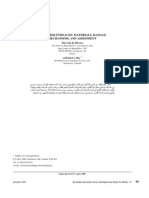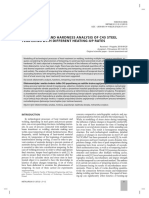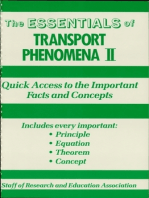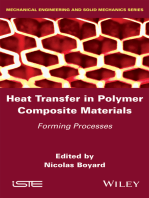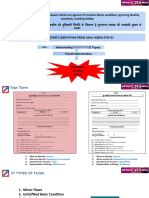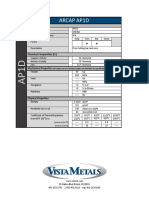Spray Water
Spray Water
Uploaded by
vinay956Copyright:
Available Formats
Spray Water
Spray Water
Uploaded by
vinay956Original Title
Copyright
Available Formats
Share this document
Did you find this document useful?
Is this content inappropriate?
Copyright:
Available Formats
Spray Water
Spray Water
Uploaded by
vinay956Copyright:
Available Formats
Measurements of Spray Water Cooling Heat Transfer Coefficients Under Oxide Scale Formation Conditions
Renáta Viščorová1, Reinhard Scholz2, Karl-Heinz Spitzer1, Jens Wendelstorf1
Clausthal University of Technology,
1
Institute of Metallurgy, Robert-Koch-Strasse 42
2
Institute for Energy Process Engineering and Fuel Technology, Agricolastr. 4
D-38678 Clausthal-Zellerfeld, Germany
Tel.: +49.5323.72-2267
Fax: +49.5323.72-3120
E-mail: renata.viscorova@tu-clausthal.de
Key words: scale formation, spray water cooling, continuous casting, hot rolling, heat transfer coefficient
INTRODUCTION
Spray water cooling is an important technique used for cooling in steel materials production processes, e.g. as part of the casting and
rolling procedure [5,14]. Due to the high temperatures, especially after a furnace treatment, the steel surface is oxidized. A lack of
knowledge about the influence of this oxide layer (scale) on heat transfer conditions may prevent a quantitative prediction of the heat
transfer coefficients during water spray cooling. For predictable homogenous cooling procedures, especially the dependence of the
heat transfer coefficient (HTC) on its principal parameters, the surface temperature and the water mass flow density, is required. For
instance, a lower and particularly non-uniform cooling can lead to structure inhomogeneities, tensions and finally cracks. Also the
plant layout and the installation of optimal spraying plans aggravate themselves by insufficient knowledge about the heat influence of
the oxide scale. An optimal temperature control can be hindered at heat treatments, at hardening and tempering as well as in the outlet
area after warm-rolling, depending on character of the formed oxide layer.
It is very important to know the interrelationship between oxide scale formation and heat transfer and after that to be able to predict
them for different process conditions. The temperature of the metal surface is one of the decisive factors for the growth of the oxide
layer, which again is determined by the heat transfer. The layer of the oxide scale forms a resistance for the heat transfer. Additionally
due to the cooling process mechanical tensions arise between the oxide layer and the bulk material which lead to spallation and thus
again to changes of the heat transfer conditions. Spray water cooling as an important technology used in steel industry for the cooling
of materials from temperatures up to 1800K and it will be investigated in this paper.
For the description of boundary conditions for heat transport problems, the concept of the Heat Transfer Coefficient (HTC) α is used,
which is defined through its relation to the heat flow density to the surface q [W/m2]:
q = α ⋅ (TS − TW ) .
For the case of spray water cooling, TW is the water temperature, while TS is the (local) surface temperature. This approach is most
valuable for situations where α is constant, i.e. not depending on TS. It can also be used for any general heat flow q by using a function
for α depending on the same parameters as q. In the so-called steady film boiling regime, α is known to be a function of the water
mass flux density [3-10]. Below a specific surface temperature TL, the heat transfer coefficient shows a strong dependence on
temperature (Leidenfrost effect [1-2,13]). In this paper, the heat transfer coefficient was measured by an automated cooling test setup
(instationary method, see Figure 1 and the discussion in [4]) under oxidizing and non-oxidizing sample surface conditions. Compared
to the previous state-of-the-art [3-10,12-14], an additional temperature dependency in the high temperature regime was investigated
and more emphasis on the determination of the measurement precision was undertaken (which is known to be a significant problem,
e.g. [4]).
Spray water cooling of steel materials introduces additional effects due to the formation of oxide layers (scale) [10,12]. The growth of
the oxide scale on the investigated steel surface will be described. Heat transfer experiments under scale formation conditions will be
presented and discussed.
AISTech 2006 Proceedings - Volume II 519
EXPERIMENTAL PROCEDURE
The thin sheet specimens of cold rolled metals with a thickness from 1-3 mm were machined to discs with 70mm in diameter. Three
thermocouple pairs, one in the middle and the others with 10 mm of distance, were spot welded to the lower side of the sample discs.
The temperature measurement was carried out with Ni-CrNi thermocouples with a wire diameter of 0.5mm. The thermocouple wires
were isolated by thin ceramic tubes. The experimental set-up sketched in Figure 1 was used for heating, oxidizing the samples and
measurement of the temperature during spray cooling.
Magnetic valve
Cooling water Volume flow
measuring instrument
Furnace (7,5kW / 1500°C)
Nozzle field
Steel sample
Sample
supporting stand
Electricity supply and
furnace temperature
control Sample-cross bar
D
Measuring and control
system
Gas supply unit - temperature
measurement
- cross bar control
Air
Argon
Figure 1: Sketch of the experimental set-up.
After installation in the furnace sample holder, the disks prepared as described above were heated up e.g. to 1000 °C under protective
atmosphere. For the measurements with scale, the sample was oxidized in the furnace by supplying Air instead of Argon for a specific
time and temperature. Reaching the test condition (temperature, oxidation time) the sample was moved automatically from the furnace
under the full cone nozzle which takes approximately 4 seconds and subsequently cooled with spray water. The spray water mass-flux
density VS was determined experimentally and varied in the range of about 3.8±1 to 25±1 kg m2 s-1. The water temperature Tw was
approximately 18 °C. The compositions of two materials investigated, obtained by chemical analysis, are presented in Table I.
Specimen Material C Mn P S Si Cr Ni
Thermax AISI 314 0.15 - - - 2.0 25 20
DC04 AISI 1008 0.03 0.21 0.009 0.007 0.02 0.02 -
Table I: Chemical analysis of the specimens (in wt. %).
520 AISTech 2006 Proceedings - Volume II
MEASUREMENT OF THE HTC TO A NON-OXIDIZED SURFACE
For the investigation of the HTC from a non oxidized surface, heat resistant steel (Thermax, AISI 314) was used. It was chosen as the
test material because surface oxidation is minimised, and the physical properties are known within the temperature range being
studied. The materials were annealed at 1000 °C under protective atmosphere and consequently cooled with spray water. The cooling
curves were measured at three points for each sample as described above. Figure 2 shows the cooling curves of the Thermax
specimens for different water mass flux densities. In the diagram only one curve for every sample is demonstrated. The sample
reaches the spray water cooling position after about 4.2 seconds. The cooling starts in the range of stable film boiling. The primary
effect of the water mass flux density VS can be seen by comparing the different cooling curves. When increasing VS from 3.8 up to 25
kg m2 s-1 the sample is cooled more quickly. At approximately 400-500 °C, dependent on VS, the cooling curves bend. At this point the
Leidenfrost temperature is reached and more rapid cooling begins (unstable film boiling).
1000
AISI 314
900
800
700
temperature T[°C]
600
500
400
300
water mass flux
200
density Vs [kg m-2s-1] 25 18 12 8 4
100
4 5 6 7 8 9 10 11
time t[s]
Figure 2: Cooling curve for different water mass flux densities VS (spray water cooling of the Thermax steel).
Figure 3 shows heat transfer coefficient α in dependence on the temperature difference ∆T≡TS-TW between surface temperature and
the water temperature for different water mass flux densities VS. The heat transfer coefficient was calculated analytically from the
measurement data. The following equation was used:
ρ ⋅ c p (T ) ⋅ d ∂T
α ≈− ⋅ (1)
T − TW ∂t z =0
with:
α heat transfer coefficient [W m-2 K-1]
cp specific heat capacity of the sample [J kg K-1]
d thickness of the sample [m]
z vertical coordinate (bottom: z=0, top: z=d) [m]
t time [s]
ρ mass density of the sample [kg m-3]
T temperature measure at the lower side (U, Fig.5) [K]
Tw temperature of spray water [K]
AISTech 2006 Proceedings - Volume II 521
Equation (1) is valid for thin samples such as in this case (d=1 mm) because of the small temperature difference between the cooled
top and the measurement point at the bottom. The Specific heat capacity cp of the AISI 314 depending on temperature was calculated
with the Thermocalc® Software based on the chemical analysis and using the TCFE3 database.
In the open literature, the HTC in the range of stable film boiling (i.e. above ∆T=600K) is assumed to be independent of the surface
temperature. As shown in Figure 3, for the higher spray water densities, VS = 18 and 25 kg m2s-1 there is a decrease in the measured
HTC even in the stable film boiling regime.
13000
water mass flux density Vs [kg m-2s-1] AISI 314
25
12000
18
12
11000
8
heat transfer coefficientt α [W m-2K-1]
4
10000
9000
8000
7000
6000
5000
4000
3000
2000
1000
0
150 250 350 450 550 650 750
temperature difference ∆T [K]
Figure 3: Heat transfer coefficient towards a non-oxidised sample in dependence
on temperature difference for different water mass flux densities.
MEASUREMENT OF THE HTC TO AN OXIDIZED SURFACE
Following the initial considerations (see below and [10]) and the basic knowledge on scale properties (e.g. [11]), the determination of
the influence of scale on the heat transfer conditions introduces some difficulties due to the following reasons:
• Thin scale layers (<10µm) may show enough adhesion for measurement but imply a very small heat resistance (“no effect”).
• Small gas layers between the scale and the substrate (blistering) imply a big effect on heat resistance (“random effect”).
• The adhesion of medium thickness scale layers (10..200µm) may be not sufficient to withstand spray water – spallation and
descaling occurs (“instationary effect”).
• Thicker scale layers (>200µm) are removed rapidly by the spray water – the thermal effect becomes inhomogeneous.
Regardless these arguments, the practical importance remains and thus the influence of an oxide layer on heat transfer was
investigated in a second set of experiments in which the low alloy material AISI 1008 was used. In order to get well defined scale
formation, the oxidation kinetics was determined in the first step.
Measurement of the oxidation kinetics
In the first part of the study the high temperature oxidation kinetics of different steel materials was examined. The specimens were
oxidized in a horizontal furnace at 650, 750, 850 and 1000 °C. The furnace was connected through a two-way valve to gas lines
supplying protective gas (Ar 97% +H2) or air. The samples were kept under protective atmosphere until the desired temperature was
reached. Subsequently, the atmosphere was changed over to air for oxidizing of the steel for a certain time. After the oxidation, the
sample was cooled down to room temperature again under protective gas atmosphere. The pressure was 1 bar. The thickness of the
522 AISTech 2006 Proceedings - Volume II
oxide layers was measured by means of an optical microscope on polished cross sections of the samples. All experiments in air show,
in principle, the well known a parabolic growth law. The time dependent oxidation process can be approximated by the function:
s = 2⋅k ⋅t (2)
s thickness of the oxide scale [m]
k growth constant [m2 s-1]
t time [s]
The parabolic growth “constant” shows an Arrhenius type temperature dependence:
EA
−
k = k0 ⋅ e R⋅T
(3)
k0 oxidation constant [m2 s-1]
EA activation energy [J mol-1]
R molar gas constant [Jmol-1K-1]
100
s@µmD
50
2000
t@sD
500
600
1000
700
T@°CD 800
900
Figure 4: Scale layer thickness depending on oxidation time and temperature.
Figure 4 shows the scale growth on low carbon steel (AISI 1008). For calculation of the thickness of oxide scale depending on
oxidation temperature and time, the values EA= 200 kJ mol-1 and k0=5·10-3 m2 s-1 were used. As can be seen in this diagram, the
growth of the oxide scale layer enhance parabolic with increasing time and exponentially with increasing temperature. It should be
noted, that, depending on thickness and cooling conditions, the spallation of the oxide scale begins. Scale layers are thus not stable
against thermal cycling. This investigation of the growth of oxide scale was determined in order to predict the scaling of the specimens
for the heat transfer experiments, where these results were used. The samples were heated up to 1000 °C as described in the first set of
experiments. After reaching of the temperature the samples were oxidized for a specific time to obtain a certain thickness of the oxide
scale and subsequently cooled by spray water to ambient temperature.
AISTech 2006 Proceedings - Volume II 523
Modelling of HTC for an oxidized surface
For understanding the influence of oxide layer on heat transfer during spray water cooling, the mechanism of heat transfer at an
oxidized surface is theoretically described first. Since design calculations often can not include thin layer effects, an effective heat
transfer coefficient containing all scale layer effects is introduced. The heat flow is thus described by an effective heat transfer
coefficient which is using the temperature difference between the steel surface and the temperature of the water (see Figure 5):
Tw
spray water
surface
S
scale
B
q
heat flow
metal
U
thermocouple
Figure 5: Heat transfer to an oxidized sample.
q = α eff ⋅ (TB − TW ) (4)
q heat flow density [W m-2]
αeff effective heat transfer coefficient [W m-2 K-1]
TB temperature at the steel-scale interface [K]
The heat transfer from the surface to the spray water is given by
q = α ⋅ (TS − TW ) , (5)
and the heat transfer through the oxide layer can be approximated by
λsc
q= ⋅ (T − T ) (6)
δ sc B S
λsc heat conductivity of the scale layer [W m-1 K-1]
δsc thickness of the scale layer [m]
TS temperature at the surface of the oxide scale [K]
Under quasi-stationary conditions and for uniform cooling, the heat flow (4) from the surface to the cooling water (5) is equal to the
heat flow through the scale layer (6) and we get the effective HTC defined by (4):
1
α eff (TB ) = (7)
1 δ
+ sc
α (TS ) λsc
The effective heat transfer coefficient αeff contains the influence of the oxide layer (thermal insulation, temperature drop). It can be
calculated by (7) using the HTC α(TS,VS) at the surface, which does not depend on bulk material properties. Accurate measurements of
α without scale thus can be applied for surfaces with well defined oxide according to equation (7). Additionally, a measurement using
an oxidized surface and equation (1) for analysis will yield to a “measured” αeff .
524 AISTech 2006 Proceedings - Volume II
RESULTS
The “expected” (calculated from equation (7)) and the corresponding “measured” temperature dependence of the effective HTC for an
oxidized sample is shown in Figure 6. As material AISI 1008 and for the water impact density VS= 3.8 kg m-2 s-1 was used. The solid
lines show the dependence of the HTC on temperature as calculated according to (1) from the experimental data for un-oxidized (0
min, i.e. αeff = α) and oxidized samples (3 min and 5 min air at 1000°C). Assuming a scale layer thickness of 100 and 200 µm and
using a heat conductivity of the oxide layer of λsc=3 W m-1K-1 [11], the effective HTC calculated by (7) is also plotted (dashed lines).
These investigations indicate, that with increasing oxide layer thickness at constant water mass flux density the αeff values decrease
only in the burnout regime (partial film boiling) and the temperature corresponding to the Leidenfrost point move to higher values. In
the area of stable film boiling the αeff (TB) values are approximately equal to α(ΤS), as long as λsc/δsc is much greater than α.
As can be seen in the diagram, the experimental findings show qualitative agreement with the calculations. The “0 min” curve
corresponds to the sample without scaling. Increasing oxide scale to ~100 µm in thickness (3 min air at 1000°C, second line)
respectively to ~140 µm (third line) the predicted behaviour was observed. The Leidenfrost point enhances from ∆T~420 K to ~450 K
at 3 min and further more to 540 K for 5 min oxidation time. This can be explained by a lower temperature at the scale layer top
surface leading to an earlier onset of unstable film boiling.
It should be noted that for these experiments, the oxide scale was adhesive in the region of the sample where on the back side the
thermocouples for the measuring of the cooling curves were located. It must be mentioned that during a cooling process the state of
the oxidized steel surface can change rapidly due to the separation or partial spallation of the oxide scale. This process is purely
stochastic. Formation of a gas gap between the steel surface and the oxide layer can also happen. In this case, the gap establishes a
larger heat transfer resistance and prevents the heat from flowing towards the scale layer. If, for instance, a 100 µm air gap is formed
this will imply an αeff decrease from approximately 600-700 W m-2K-1 down to 200 W m-2K-1 in the temperature range of stable film
boiling. As a consequence, spatial inhomogeneous heat removal from the surface will cause heat flows by conduction within the
surface plane. These αeff “measurements” are thus not as accurate as the measurements without surface oxidation.
10000
oxidation time in air at 1000°C: AISI-1008, d=1.5mm, Vs = 3.8 kg m-2s-1
9000
0 min
8000
heat transfer coefficient α [W m-2K-1]
eq. (7) for δsc=
7000
100µm
200µm
6000
3 min
5000
4000
eq. (1)
3000
5 m in
2000
1000
0
100 200 300 400 500 600 700 800 900
temperature difference (TB-TW) [K]
Figure 6: Effective heat transfer coefficient in dependence on temperature difference for different oxidation times.
AISTech 2006 Proceedings - Volume II 525
For discussion, the HTC in the stable film boiling regime is plotted against its parameter, the water impact density. Figure 7 exhibits
the heat transfer coefficient with and without scaling, depending on the water mass flux density under variation of material and
temperature difference ∆T=TS-TW. The grey area demonstrates the open literature values for ∆T = 700 K, which proves that the heat
transfer coefficient is a strong function of water mass flux density in the range of stable film boiling. Additionally, the results indicate
an additional temperature dependency even in the so called stable film boiling regime. A further discussion of the measurement
precision seems to be very important. The current developments approach a 25% accuracy for the determination of the HTC while the
scatter in the literature data is about 40% in the stable film boiling regime. Below ∆T=500K, approaching the Leidenfrost point, the
measurements are somewhat less accurate.
For oxidized surfaces showing descaling during cooling, the local HTC varies spatial and with time. The mean value and its statistics
needs to be investigated in greater detail. Without blistering, stable adhesive scale surface layers need to grow thicker than 250µm in
order to influence the local heat transfer coefficient (see equation (7)).
5000
Ni, 700 °C
4500
Ni, 800 °C
4000
heat transfer coefficient α [W m-2K-1]
Ni, 1000 °C
3500
3000
2500
2000
AISI 314, 700 °C
AISI 314, 800°C
1500
AISI 1008, 700°C
1000
literature AISI 1008, 800°C
data
500 for
∆T=700 K
0
0 5 10 15 20 25
-2 -1
water mass flux density vs [kg m s ]
Figure 7: Heat transfer coefficient without oxidation under variation of the material and temperature.
526 AISTech 2006 Proceedings - Volume II
SUMMARY AND CONCLUSIONS
In this study, spray water cooling of steel materials from initial temperatures up to 1000°C was investigated. The (low alloy) AISI-
1008 steel and - for comparison - the (stainless) AISI-314 was used for the experiments. The heat transfer coefficient was measured by
an automated cooling test (instationary method). This allows for a determination of the HTC α depending on the surface temperature
T, within a single experiment (Figure 6). The second parameter, the water mass flux density VS, was varied from 3.8 to 25 kg m-2s-1
(Figure 3 and Figure 7).
Furthermore, spray water cooling of steel materials introduces additional effects due to the formation of oxide layers (scale). In order
to investigate the influence of an oxide layer on heat transfer the high temperature oxidation of steel was examined first. For these
experiments the AISI-1008 steel was used. The samples were oxidized in atmospheric air at different temperatures and for specific
times. Subsequently the thickness of the oxide scale was determined. The temperature-dependent parabolic growth “constant” k was
determined from the experimental data for the scale layer thickness versus oxidation time at a certain temperature. The temperature is
the main parameter for the thickness of the oxide layer, because the oxidation reaction rate increases exponentially with temperature,
according to activation energy Q0. Using k0 and Q0 it was possible to describe the oxide layer growth on the surface of AISI-1008 steel
materials (Figure 4). These results are used to calculate the scale layer thickness in the HTC experiments.
Finally, the heat transfer coefficient was measured for samples with (initial) scale layers (Figure 7). For the assessment of the scale
layer effect and application purposes, an effective heat transfer coefficient αeff was defined. Heat transfer experiments for oxidized
samples were presented and discussed. Summarizing, we observed
• An additional temperature dependency in the high temperature (stable film boiling) regime was found, thus the HTC is also
temperature-dependent above the Leidenfrost temperature – simple α(VS) relations are very inaccurate.
• For the quantitative description of the oxide scale formation, spallation has to be taken into account.
• In the lower ∆T (unstable film boiling) regime, scale layers can dramatically influence the apparent HTC.
• The oxide layers mainly impede heat transfer by random formation of an isolating gas gap between the oxide and the bulk
material (blistering).
• Spallation of the oxide scale and thus scale plates moving around additionally influence local and global cooling conditions.
As a conclusion, the heat transfer coefficient (HTC, α) introduced by
q = α ⋅ (TS − TW )
fulfils numerical stability requirements for spray water cooling calculations. Nevertheless, α is a complex function of the surface
temperature, the water mass flow density and the surface condition. The indirect measurement of α was demonstrated by thin sheet
cooling experiments. Future work should be devoted to further enhancements with respect to the measurement precision and the
statistics caused by the blistering and spallation of scale layers. While the effect of a stable adhesive scale layer on heat transfer was
predicted and measured in this paper, further investigations of the mean HTC and its statistics under scale formation, blistering and
spallation conditions are subject to current research. This paper and future work provides the data required for more defined and
predictable spray water cooling and e.g. thus avoid material inhomogeneity due to inhomogeneous cooling procedures.
ACKNOWLEDGEMENTS
This work was partially supported by the German ministry of commerce (BMWA) under the supervision of the AiF member society
VDEh Gesellschaft zur Förderung der Eisenforschung under Ref. No. 139133N. We express our gratitude to the financial supporters,
to the industrial steering committee of the project and to our technicians, especially to Mr. Hillebrecht with his outstanding long term
experience in the field of HTC measurement.
AISTech 2006 Proceedings - Volume II 527
REFERENCES
[1] J. G. Leidenfrost, “De Aquae Communis Nonnullis Qualitatibus Tractatus”, Duisburg, 1756, see also
International Journal of Heat and Mass Transfer, Vol. 9, pp. 1153-1166 (1966).
[2] B.S. Gottfried, C. J. Lee, and K. J. Bell, “The Leidenfrost Phenomenon: Film Boiling of Liquid Droplets on a Flat Plate”,
International Journal of Heat and Mass Transfer, Vol. 9, pages 1167–1187 (1966).
[3] A. Eugene and A. Mizikar, “Spray Cooling Investigation for Continuous Casting of Billets and Blooms,”
Iron and Steel Engineer, Vol. 47, No. 6, June 1970, pp. 53-60.
[4] N. Lambert and M. Economopoulos, “Measurement of the heat-transfer coefficients in metallurgical processes”,
Journal of the Iron and Steel Institute, October 1970, pp. 917-928.
[5] A. Diener, “Der Wärmeübergang beim Spritzkühlen heißer Stahloberflächen - Eine Schrifttumsübersicht zum Stand der
Kenntnisse,” Stahl und Eisen, Vol. 96, Nr. 4, 1976, pp. 165-168.
[6] H. R. Müller and R. Jeschar, “Wärmeübergang bei der Spritzwasserkühlung von Nichteisenmetallen”,
Zeitschrift für Metallkunde, Vol. 74, No. 5, 1983, pp. 257-264.
[7] U. Reiners, R. Jeschar, R. Scholz, D. Zebrowski and W Reichert, “A measuring method for quick determination of local heat
transfer coefficients in spray water cooling within the range of stable film boiling,”
steel research, Vol. 56, No. 5, 1985, pp. 239-246.
[8] M. Bamberger and B. Prinz, “Determination of heat transfer coefficients during water cooling of metals”,
Materials Science and Technologie, Vol. 2, Apri1 1986, pp. 410-415.
[9] R. Jeschar, R. Scholz, U. Reiners and R. Maaß, “Kühltechniken zur thermischen Behandlung von Werkstoffen,”
Stahl und Eisen, Vol. 107, No. 6, Jun 1987, pp. 23-30.
[10] C. Köhler, R. Jeschar, R. Scholz, J. Slowik and G. Borchardt,
“Influence of oxide scales on heat transfer in secondary cooling zones in the continuous casting process, Part I:
heat transfer through hot-oxidized steel surfaces cooled by spray-water”,
steel research 61, Vol. 61, No. 7, 1990, pp. 295-301.
[11] J. Slowik, G. Borchardt, C. Köhler, R. Jeschar and R. Scholz,
“Influence of oxide scales on heat transfer in secondary cooling zones in the continuous casting process”, Part II:
determination of material properties of oxide scales on the steel under spray-water cooling conditions,
steel research, Vol. 61, No. 7, 1990, pp. 302-311.
[12] W. H. Zhou and F. S. Du, “Effect of Oxide Scale on Interfacial Heat Transfer during Slab Hot Rolling,”
J. Iron & Steel Research International, Vol. 9, No. 2, Nov. 2002, pp. 21-23.
[13] R. Weber, “Boiling”, Lecture Notes in Heat Transfer, Clausthal-Zellerfeld, Germany, 2004, pp. 162-164.
[14] J. Sengupta, B. G. Thomas and M. A. Wells, “The Use of water Cooling during the Continuous Casting of Steel and
Aluminium Alloys,” Metallurgical and Materials Transactions A, Vol. 36A, Jan. 2005, pp. 187-204.
528 AISTech 2006 Proceedings - Volume II
You might also like
- CSWIP 3.0 Welding InspectionDocument43 pagesCSWIP 3.0 Welding InspectionScott K.L LeeNo ratings yet
- Design of Steel StructuresDocument2,529 pagesDesign of Steel StructuresStructural Spreadsheets70% (10)
- Thermal ConductivityDocument17 pagesThermal Conductivityقاسمي عندام50% (2)
- As 2574-2000 Non-Destructive Testing - Ultrasonic Testing of Ferritic Steel CastingsDocument9 pagesAs 2574-2000 Non-Destructive Testing - Ultrasonic Testing of Ferritic Steel CastingsSAI Global - APAC0% (1)
- Effect of Controlling Parameters On Heat Transfer During Spray Impingement Cooling of Steel PlateDocument9 pagesEffect of Controlling Parameters On Heat Transfer During Spray Impingement Cooling of Steel PlateAJER JOURNALNo ratings yet
- Thermal Conductivity ReportDocument10 pagesThermal Conductivity ReportAmos Onyepuruikoluchukwu Ngwoke100% (1)
- 01 - A CCT Diagram For An Offshore Pipeline Steel of X70 TypeDocument6 pages01 - A CCT Diagram For An Offshore Pipeline Steel of X70 TypeŞarîngă George AlexandruNo ratings yet
- Heat Transfer Operation Manual-19-20Document60 pagesHeat Transfer Operation Manual-19-20Abhay RajputNo ratings yet
- Thermal Fatigue Stainless SteelDocument12 pagesThermal Fatigue Stainless SteelluisNo ratings yet
- Thermal and Fluid Flow Modelling of A Heating Bed For Application in Metal AM ProcessLecture Notes in Mechanical EngineeringDocument9 pagesThermal and Fluid Flow Modelling of A Heating Bed For Application in Metal AM ProcessLecture Notes in Mechanical EngineeringAshishYadavNo ratings yet
- Thermal Conductivity Determination of Small Polymer Samples by Differential Scanning CalorimetryDocument5 pagesThermal Conductivity Determination of Small Polymer Samples by Differential Scanning Calorimetrycarlette11No ratings yet
- Transfer Hasan 2011 PDFDocument14 pagesTransfer Hasan 2011 PDFmalikaNo ratings yet
- Differential Thermal Analysis and Differential Scanning CalorimetryDocument12 pagesDifferential Thermal Analysis and Differential Scanning CalorimetryZahir Rayhan Jhon100% (1)
- Correlation Between Heat-Checking Resistance and Impact Bending Energy of Hot-Work Tool Steel Din 1.2344Document17 pagesCorrelation Between Heat-Checking Resistance and Impact Bending Energy of Hot-Work Tool Steel Din 1.2344Irwan KmNo ratings yet
- Thermal Shock Resistance Predictionms PDFDocument10 pagesThermal Shock Resistance Predictionms PDFkonstantasNo ratings yet
- Austenitic Enthaply SpecificheatDocument9 pagesAustenitic Enthaply Specificheat조기현/초빙교수/스마트소재부품공학No ratings yet
- Multiple Cycle MartensiteDocument8 pagesMultiple Cycle MartensitePracheeGuptaNo ratings yet
- Effect of Pressure On Biomass PyrolysisDocument22 pagesEffect of Pressure On Biomass PyrolysisLeta DerejeNo ratings yet
- Quenchant Characterization by Cooling Curve Analysis Lauralice C.F. Canale, Xinmin Luo, Xin Yao and G.E. TottenDocument47 pagesQuenchant Characterization by Cooling Curve Analysis Lauralice C.F. Canale, Xinmin Luo, Xin Yao and G.E. Tottenluis enriqueNo ratings yet
- Experiment # 01: Lab ReportDocument12 pagesExperiment # 01: Lab ReportMuhammad TayyabNo ratings yet
- Effects of PWHT Temperature On Mechanical Properties PDFDocument11 pagesEffects of PWHT Temperature On Mechanical Properties PDFA K SinghNo ratings yet
- Mechanical Principles (ENGD1005) - Measurement of Thermal ConductivityDocument7 pagesMechanical Principles (ENGD1005) - Measurement of Thermal ConductivityZareen Rashid ChoudhuryNo ratings yet
- MPU-Heat-and-Mass-Transfer-Lab mannualDocument42 pagesMPU-Heat-and-Mass-Transfer-Lab mannualkajalrawatr247No ratings yet
- Exp. 4 (Thermal Conductivity) : Sultan Qaboos University College of EngineeringDocument18 pagesExp. 4 (Thermal Conductivity) : Sultan Qaboos University College of Engineeringقاسمي عندامNo ratings yet
- ASME Abstract-Qibin-YeZhang2018222Document6 pagesASME Abstract-Qibin-YeZhang2018222Ye ZHANGNo ratings yet
- Detremination of CCT Diagrams by Thermal Anal of HSLA Bainitic Submitet To Thermomech TreatDocument5 pagesDetremination of CCT Diagrams by Thermal Anal of HSLA Bainitic Submitet To Thermomech TreatLjubica MilovicNo ratings yet
- Simulation and Control of The Cooling of Hot Rolled Steel Wire RodDocument8 pagesSimulation and Control of The Cooling of Hot Rolled Steel Wire RodmirellespindolaNo ratings yet
- ICONE-8778: Visualization of Forced Convection Heat Transfer For Carbon Dioxide in Supercritical ConditionDocument5 pagesICONE-8778: Visualization of Forced Convection Heat Transfer For Carbon Dioxide in Supercritical ConditionBobKatNo ratings yet
- Thermal AnalysisDocument14 pagesThermal AnalysisSaurav GargNo ratings yet
- Mathematical Modelling of Steel QuenchingDocument6 pagesMathematical Modelling of Steel Quenchingmanashree02No ratings yet
- Short-time Oxidation Behavior of Low-carbon low silicon steel in air at 850-1180 - IDocument30 pagesShort-time Oxidation Behavior of Low-carbon low silicon steel in air at 850-1180 - IFrankNo ratings yet
- The Specific Heat of AluminiumDocument4 pagesThe Specific Heat of AluminiumChrise RajNo ratings yet
- A New Technique For Heating Specimens in Split-Hopkinson-Bar Experiments Using Induction-Coil HeatersDocument4 pagesA New Technique For Heating Specimens in Split-Hopkinson-Bar Experiments Using Induction-Coil HeatersHebert GranadosNo ratings yet
- Chemical Engineering Lab-1 CHE F312: (Group-2)Document16 pagesChemical Engineering Lab-1 CHE F312: (Group-2)Superset NotificationsNo ratings yet
- Heat and Surface Treatment of Hot Work TDocument17 pagesHeat and Surface Treatment of Hot Work TakashnirmalyamNo ratings yet
- Heat Transfer Analysis of Blast Furnace StaveDocument10 pagesHeat Transfer Analysis of Blast Furnace StavemetalmasaNo ratings yet
- Heat Transfer Lab Observaton: Sri Venkateswara College of Engineering and TechnologyDocument66 pagesHeat Transfer Lab Observaton: Sri Venkateswara College of Engineering and TechnologyMd Naim HossainNo ratings yet
- Reformer Furnaces - Material, Damage Mechanism and AssessmentDocument21 pagesReformer Furnaces - Material, Damage Mechanism and AssessmentMuhammad Noor FadhliNo ratings yet
- Kom Manual PDFDocument44 pagesKom Manual PDFShivam DoharNo ratings yet
- Numerical Modelling of Heat Transfer in A Tube Furnace For Steel Wire AnnealingDocument10 pagesNumerical Modelling of Heat Transfer in A Tube Furnace For Steel Wire AnnealingEr Vijay MishraNo ratings yet
- CFD Study Heat PipeDocument8 pagesCFD Study Heat PipeSalman Chowdhury ShawonNo ratings yet
- Dilatometric and Hardness Analysis of C45 Steel Tempering With Different Heating-Up RatesDocument4 pagesDilatometric and Hardness Analysis of C45 Steel Tempering With Different Heating-Up RatesInaamNo ratings yet
- Dilatometric and Hardness Analysis of C45 Steel PDFDocument4 pagesDilatometric and Hardness Analysis of C45 Steel PDFInaamNo ratings yet
- Dilatometric and Hardness Analysis of C45 Steel Tempering With Different Heating-Up RatesDocument4 pagesDilatometric and Hardness Analysis of C45 Steel Tempering With Different Heating-Up RatesInaamNo ratings yet
- Tep Lab Lab Report Experiment # 01: Study of Linear Heat Conduction Through Aluminium and Stainless-Steel BarDocument11 pagesTep Lab Lab Report Experiment # 01: Study of Linear Heat Conduction Through Aluminium and Stainless-Steel BarMehndi DesignsNo ratings yet
- OF UP: Apparatus For Measuring Thermal Conductivity Metals To 600 CDocument13 pagesOF UP: Apparatus For Measuring Thermal Conductivity Metals To 600 Cnova wahyuniNo ratings yet
- Direq/CorDocument64 pagesDireq/CorMohamed Ben MansourNo ratings yet
- Veeresh FuskeleDocument5 pagesVeeresh FuskeleVeeresh FuskeleNo ratings yet
- Effect of Air Temperature On The Thermal Behavior and Mechanical Properties of Wire Rod Steel During Stelmor CoolingDocument12 pagesEffect of Air Temperature On The Thermal Behavior and Mechanical Properties of Wire Rod Steel During Stelmor CoolingmirellespindolaNo ratings yet
- Lot 6 - Calorimeter - Manual 2Document2 pagesLot 6 - Calorimeter - Manual 2MichaelNo ratings yet
- APSC182-Lab1-VL3-G6Document7 pagesAPSC182-Lab1-VL3-G6Berlin Ortiz SanchezNo ratings yet
- 2017.experimental Study On Temperature, Heat Flux, Strain and Stress Distribution of Boiler Water WallsDocument7 pages2017.experimental Study On Temperature, Heat Flux, Strain and Stress Distribution of Boiler Water WallsPajooheshNo ratings yet
- Thermal Conductivity of Magnesium Oxide From Absolute, Steady-State MeasurementsDocument7 pagesThermal Conductivity of Magnesium Oxide From Absolute, Steady-State Measurementsommech2020No ratings yet
- HT Lab Manual FinalDocument58 pagesHT Lab Manual Finalsharadesh sarnaikNo ratings yet
- Experiment 4Document12 pagesExperiment 4AhmadFirdausZainushamNo ratings yet
- The Diffusivity of Hydrogen in NB Stabilized Stainless SteelDocument6 pagesThe Diffusivity of Hydrogen in NB Stabilized Stainless Steelmehrshad_mjNo ratings yet
- Presented by - Smruti Ranjan Masanta M.PHARM (1 YR) PharmacologyDocument20 pagesPresented by - Smruti Ranjan Masanta M.PHARM (1 YR) Pharmacologyangel.lopez6383No ratings yet
- Thermal Modelling of Power Transformers Using Computational Fluid DynamicsFrom EverandThermal Modelling of Power Transformers Using Computational Fluid DynamicsNo ratings yet
- Heat Transfer in Polymer Composite Materials: Forming ProcessesFrom EverandHeat Transfer in Polymer Composite Materials: Forming ProcessesNicolas BoyardNo ratings yet
- Ceramic Materials for Energy Applications V: A Collection of Papers Presented at the 39th International Conference on Advanced Ceramics and CompositesFrom EverandCeramic Materials for Energy Applications V: A Collection of Papers Presented at the 39th International Conference on Advanced Ceramics and CompositesJosef MatyášNo ratings yet
- SKF Centralised LubricationDocument84 pagesSKF Centralised Lubricationvinay956No ratings yet
- 1QC Slide PlateDocument1 page1QC Slide Platevinay956No ratings yet
- Fugai TrainingDocument16 pagesFugai Trainingvinay956No ratings yet
- FRL (Filter Regulator Lubricator)Document4 pagesFRL (Filter Regulator Lubricator)vinay956No ratings yet
- Routine & Preventive MaintenanceDocument8 pagesRoutine & Preventive Maintenancevinay956No ratings yet
- Important Elements of SteelDocument14 pagesImportant Elements of Steelvinay956No ratings yet
- Important Elements of SteelDocument14 pagesImportant Elements of Steelvinay956No ratings yet
- Elements & Their Effects.Document81 pagesElements & Their Effects.vinay9560% (1)
- Not Failure, BT Low Aim Is A Crime.Document5 pagesNot Failure, BT Low Aim Is A Crime.vinay956No ratings yet
- ARCAP - Grades and PropertiesDocument7 pagesARCAP - Grades and PropertiesEminent RishNo ratings yet
- Questions On Section IxDocument22 pagesQuestions On Section IxNasir JavedNo ratings yet
- Load Propelling Trolley Design ReportDocument45 pagesLoad Propelling Trolley Design Reporthafizheykal0% (1)
- Metallurgical Benefits of Vanadium Microalloying in Producing High Strength Seismic Grade RebarDocument12 pagesMetallurgical Benefits of Vanadium Microalloying in Producing High Strength Seismic Grade RebarUlises Quintana Carhuancho100% (1)
- Iron and Steel Making ProcessDocument22 pagesIron and Steel Making Processmaghfira100% (1)
- Seismic Design For Special MomentDocument2 pagesSeismic Design For Special MomentreynoldNo ratings yet
- Aps Bisalloy 80 DatasheetDocument12 pagesAps Bisalloy 80 Datasheetst_calvoNo ratings yet
- ASTM F 436 Standard Specification For Hardened Steel WashersDocument6 pagesASTM F 436 Standard Specification For Hardened Steel WashersILSEN N. DAETNo ratings yet
- Steltech 2004Document45 pagesSteltech 2004tedoccontrolNo ratings yet
- CH 02Document61 pagesCH 02LeonardoMadeira11No ratings yet
- Training Report - For STUDENTSDocument52 pagesTraining Report - For STUDENTSAbdulziz kurdiNo ratings yet
- Cost Breakdown of Steel Pricing NiteshDocument4 pagesCost Breakdown of Steel Pricing Niteshnitesh.costmastersNo ratings yet
- Bomba Final 3 PDFDocument259 pagesBomba Final 3 PDFDiegNo ratings yet
- IECEx INE 14.0028U 004Document9 pagesIECEx INE 14.0028U 004waleedusman44No ratings yet
- 1 Workshop For Tech Voc HeadsDocument154 pages1 Workshop For Tech Voc HeadsArvie B. MaculNo ratings yet
- Daily Fit-Up/Welding Inspection ReportDocument7 pagesDaily Fit-Up/Welding Inspection ReportRichard PeriyanayagamNo ratings yet
- 74.00.02.000 (Stainless Steel)Document8 pages74.00.02.000 (Stainless Steel)Andres Romero PinedaNo ratings yet
- Pig Iron For Grey Iron FoundriesDocument2 pagesPig Iron For Grey Iron FoundriesArunkumar ManianNo ratings yet
- Nes 848 Part 1Document21 pagesNes 848 Part 1Jonicus-DextoreNo ratings yet
- M-001 2014 Materials SelectionDocument32 pagesM-001 2014 Materials Selectionjar_2100% (1)
- Worksheet in Roof Structure - Up4Document8 pagesWorksheet in Roof Structure - Up4Karthimeena MeenaNo ratings yet
- Arun.r. (Mba Ib) Report of Intern SailDocument60 pagesArun.r. (Mba Ib) Report of Intern Sailnitishbhardwaj123No ratings yet
- Steel ClassificationDocument27 pagesSteel ClassificationfinianurNo ratings yet
- Louis Kahn - Modernization and The New Monumentality - 1944-1972Document20 pagesLouis Kahn - Modernization and The New Monumentality - 1944-1972康心浩No ratings yet
- gb713-2008-ケッコヘムケチヲネンニテクヨー・steel plates for boilers and pressure vessels-en-ネォホトDocument13 pagesgb713-2008-ケッコヘムケチヲネンニテクヨー・steel plates for boilers and pressure vessels-en-ネォホトNguyễn Thanh TùngNo ratings yet
- Sampling Steel and Iron For Determination of Chemical CompositionDocument22 pagesSampling Steel and Iron For Determination of Chemical CompositionAmin GolestaniNo ratings yet
- W lRTEC M: Welder Qualification Test CertificateDocument1 pageW lRTEC M: Welder Qualification Test CertificateLHYT NTUANo ratings yet






































